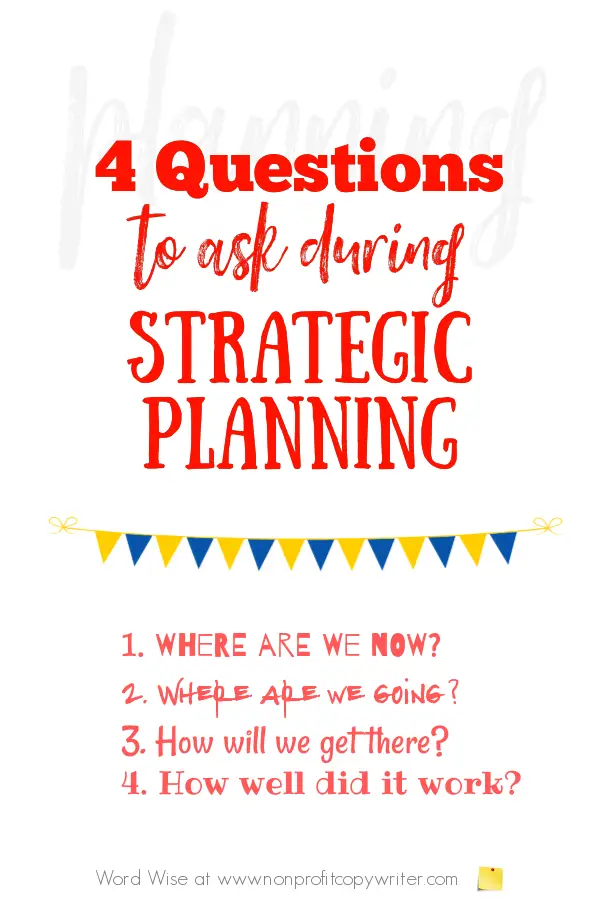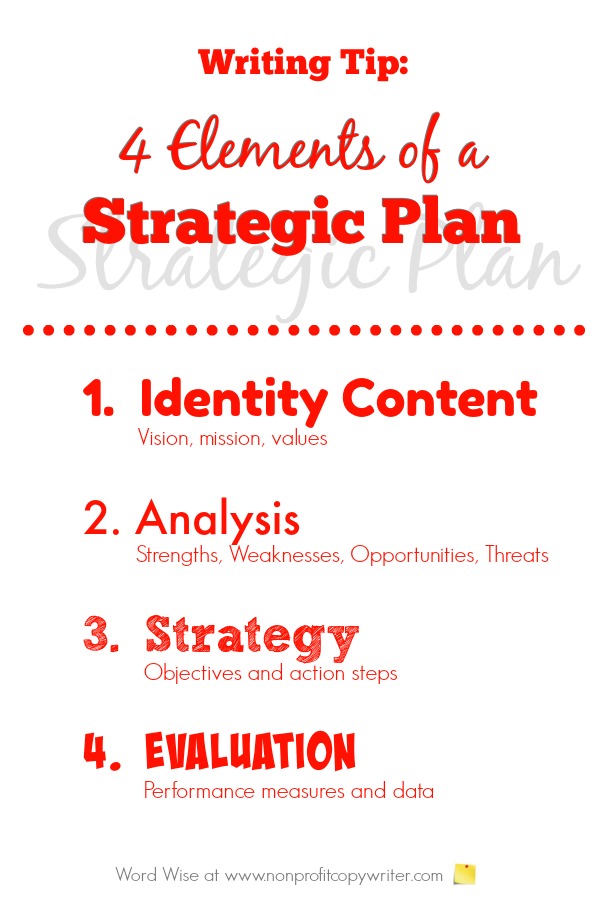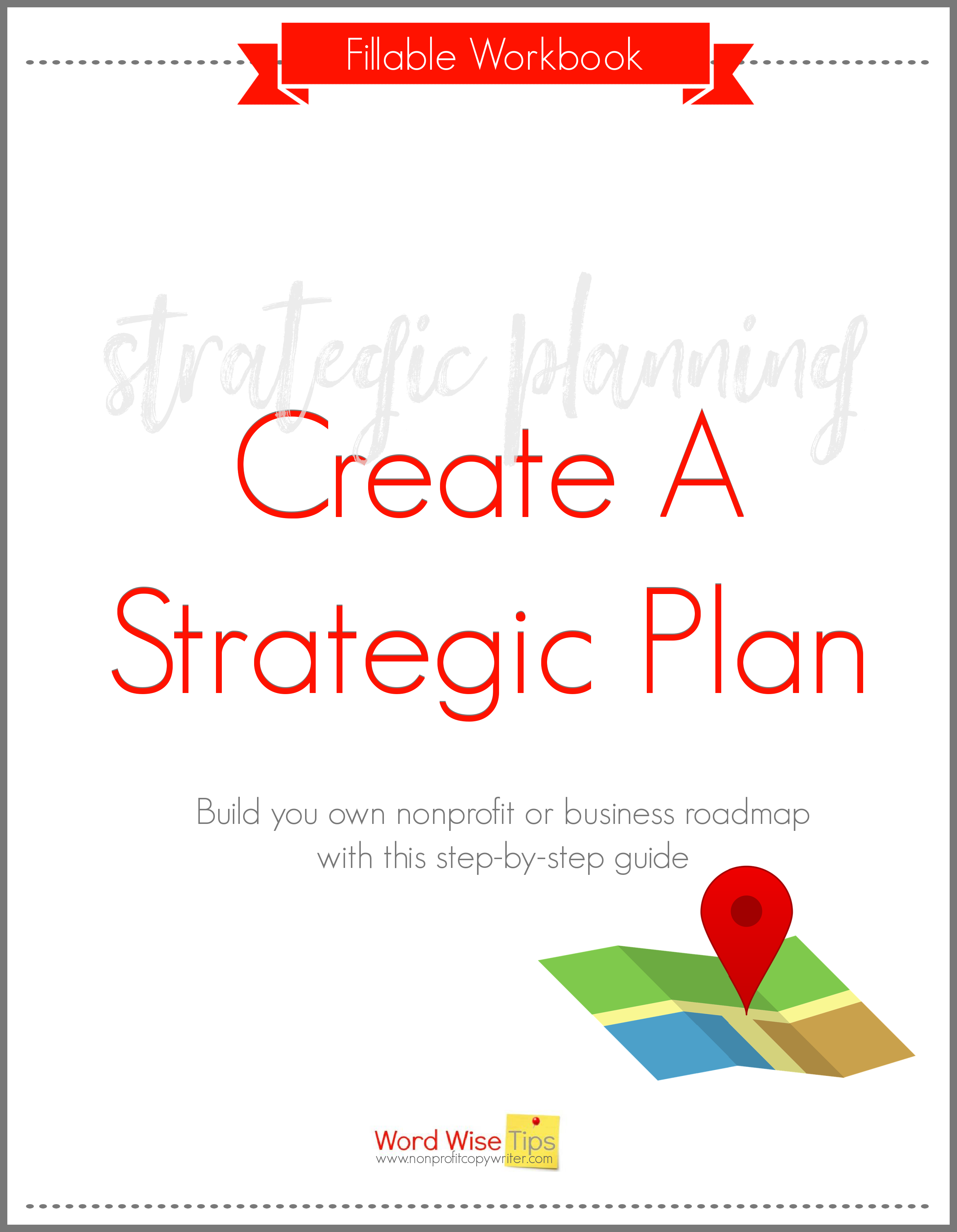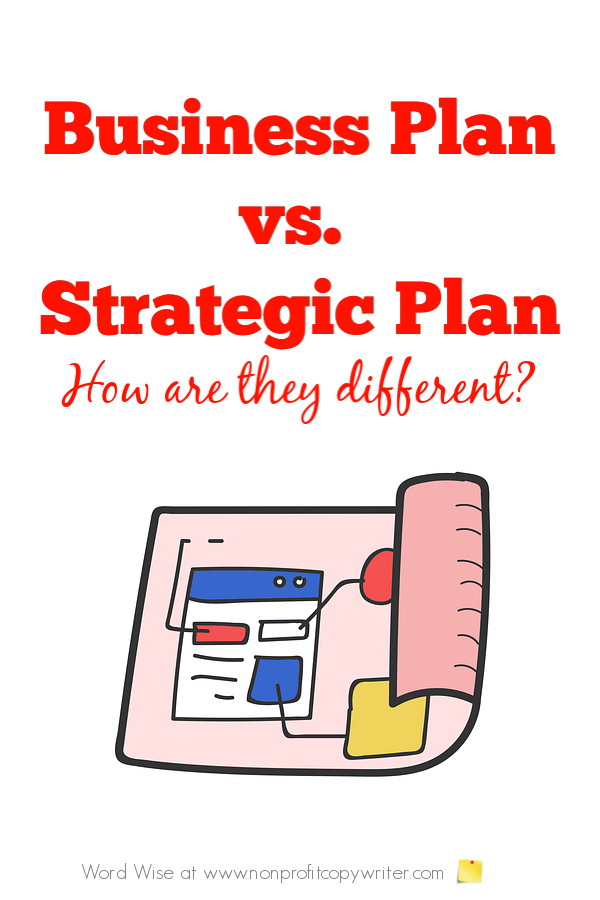
Award-winning writer Kathy Widenhouse has helped hundreds of nonprofits and writers produce successful content and has gained 600K+ views for her writing tutorials. She is the author of 9 books. See more of Kathy’s content here.
Updated 12.13.2023
Get Started With Strategic Planning for Nonprofits (or Your Small Biz): FAQs
Don’t have a strategic plan? You may not make much progress with your wonderful work. That’s why strategic planning for nonprofits, small businesses, and solopreneurs) makes good business sense.
When you don’t undertake planning, you set yourself up for frustration and even failure. “If you don’t know where you are going,” said legendary pro baseball player and coach Yogi Berra (1925-2015), “you might wind up someplace else.”
Yet the term “strategic planning” can sound intimidating if you’re a nonprofit leader who is already wearing too many hats … if you’re a new biz owner … if you’re a blogger or solopreneur who wants to build your reach. It’s an activity best relegated to seasoned professionals, right?
Wrong. You don’t need an MBA to create a strategic plan that works, even if you’re writing one for the first time. If the thought of strategic planning makes you quiver or sends you into denial, then you’re in the right place. When you have a simple outline to follow, you can feel more confident in working through the planning process. But first …
Q. What is strategic planning?
Strategic planning is an intentional process you use to create and achieve goals.
Because it’s a process, strategic planning a series of steps. It’s “strategic” in that it’s purposeful. At the end of the process, you have a product – a strategic plan.
If the term “strategic planning” still bothers you, you can refer to it as “purposeful planning” or “intentional planning.”
With plan in hand, you’ll have a course of action to take to achieve your goals for your nonprofit or your small biz. And since strategic planning is a process, you periodically evaluate and tweak your plan to keep yourself on track.
It’s a process you should undertake at regular intervals – say, at least once a year – whether you’re a nonprofit leader or a business owner or solopreneur.
Q. What
should I include in a nonprofit strategic plan (or one for a small biz)?
Various business gurus identify “5 steps of a strategic plan” or “7 stages to strategic planning” or even “16 elements your strategic plan must have.” But I’m all about making writing simple. The point of strategic planning is to figure out how to reach your goals in the most direct way, right? In my mind, it’s best to get started by focusing on basics.
Strategic planning for nonprofits boils down to four key areas. You can create your first strategic plan or update a previous one by asking and answering 4 simple questions that correspond to each of those 4 areas. You can undertake this process on your own (if you’re a solopreneur or small biz owner) or with your team (if you have key staff you’d like to include).
Q. What questions should I ask during strategic planning?
Here is a list of 4 questions you should ask yourself during the strategic planning process.
- Where are we now? (Identity)
- Where are we going? (Analysis)
- How will we get there? (Strategy)
- How well did it work? (Evaluation)
By asking and answering these four simple questions, the strategic planning process forces your nonprofit or biz to evaluate why you exist, what you do, how you do it, and your results. You’ll clarify what need you meet (your mission and values statements), what you do or don’t do to meet the need (your analysis), how you will adjust to meet those needs more effectively (your strategy), and how well your plan works so you can modify your approach the next time around (your evaluation).
Specific details in those four buckets vary from organization to organization. But if you include these four elements, you can create a plan that helps you achieve your goals. And you can add to it later, of course … since strategic planning is a process.
Q. What 4 areas
should I document during strategic planning?
1. Identity: where
are you now?
- What problem do you address? You need to know what you’re going to fix or create before you make a plan to do so. Otherwise, you’ll be doing work just for the sake of doing work.
- What is your mission statement? Articulate why you exist and whom you serve.
- What is your vision statement? Describe the desired future state or impact you aim to achieve. Your vision statement offers a long-term perspective and inspiration for stakeholders.
- What are your core values? List four to eight guiding principles that provide the ethical foundation for your work and steer your decisions and actions.
- What are your current programs or activities? Document what work are you doing right now to carry out your mission and the most recent outcomes of those programs.
2. Analysis: where are you going?
Use a SWOT analysis (Strengths, Weaknesses, Opportunities, Threats)
- What are your strengths?
- What are your weaknesses?
- What opportunities do you have?
- What threats do you face?
As you conduct your SWOT analysis, be sure to address both external factors (conditions that lead to the need you address; the service area where you work) as well as internal operations (with whom you do your work, including staff, volunteers, partners, donors, and beneficiaries.)
3. Strategy: how will you get there?
- What is your goal? Write down a broad statement about what you hope to accomplish.
- What are your objectives? Create list of specific accomplishments you’d like to achieve.
- What action steps will you take? Record measurable action steps you will take to achieve your objectives, which can include detailed responsibilities, timelines, and milestones if you choose or if you have time.
- What resources will you use? List the financial, human, physical, and technological resources you need to carry out each objective.
As you flesh out your strategy, consider these additional factors.
- Stakeholder engagement: how you will recruit and involve key stakeholders, including board members, staff, volunteers, beneficiaries, donors, and the community.
- Risk management: how you will identify potential risks and challenges, along with strategies to manage crises.
- Financial sustainability: how you will develop a long-term plan for fundraising and financial stability.
- Communication plan: how you will develop your organization’s messaging and what communication channels will you use
- Succession planning: how you will plan for leadership transitions and develop talent in your organization.
4. Evaluation: how well did it work?
- Choose metrics: identify what concrete data (“key performance indicators, or KPIS, in biz lingo) that you’ll use to measure progress in achieving your goals and objectives.
- Collect data. List the methods will you use to collect those statistics, facts, and information.
- Analyze the data: measure your outcomes. In what ways was your plan successful? What challenges did you face? What can you differently as you strategically plan your next term?
You can use this helpful workbook for creating your first (or updated) strategic plan, which includes a strategic plan template to help you put everything together.
Q. What
are the main types of strategic planning for nonprofits?
Nonprofit leaders are b-u-s-y. Most agree that strategic planning offers plenty of benefits, including focused programming, increased efficiency, better engagement with donors and beneficiaries, productive fundraising, and long-term sustainability. Even so, just 49% of nonprofits have a written strategic plan.
Maybe you’re among the 51% that don’t. If so, you can get started by creating a traditional strategic plan as outlined above.
But if that seems like an overwhelming task, you can get going by choosing just one of the types of strategic planning listed here. Once you’ve completed that planning process and begin to carry out its tasks, you can move on to another. And another.
Or you can start with couple of types of planning – recognizing their interconnected nature – to be more efficient with your time and to streamline the time you devote to planning. For example, you can create a combined Fundraising and Communications plan. Once that in place and working, you could work on a Programmatic and Community Engagement plan. Get started with these specific types of strategic planning categories.
- Capacity building planning: focus on enhancing your agency’s infrastructure, whether through growing staff, building a donor base and funding, developing your board, updating technology, or adding a physical plant.
- Programmatic strategic planning: focus on your program’s services to fulfill your mission. Develop programming to achieve greater impact on your target population or target geographic area.
- Fundraising strategic planning: focus on ways to diversify and expand your funding sources to create financial sustainability.
- Advocacy and policy planning: focus on how your organization’s mission and policies align with public policy so you can advocate for social change.
- Community engagement planning: focus on how to partner with the community, stakeholders, beneficiaries, volunteers, and other collaborators to pool resources and achieve common goals.
- Technology planning: focus on how to leverage and improve technology to stay current and efficient.
- Sustainability planning: focus on how to cultivate financial stability, a succession plan, and a resilient organization that weathers change. Often a sustainability plan includes strategies for mitigating risks and managing crises effectively.
Q. How
long should my strategic plan be?
Your plan should be long as your nonprofit needs it to be to reach your goals. That could be one page long or it could be hundreds of pages, depending on the size of your organization and its strategy. Writing tip: start simple. You can expand your strategic plan later, but it’s best to get started. Remember – no plan, no (or little) progress.
Q. What’s
the difference between a business plan and a strategic plan?
A business plan …
- Is often chosen by entrepreneurs and start ups
- Provides structure to initially define an organization
- Is used when you set up an organization, seek funding, or make a presentation to a bank
- Presents a case
- Typically covers a time period of no more than 1 year
A strategic plan …
- Is chosen by existing organizations that want to grow
- Is used to manage the direction of an organization
- Provides focus to move the nonprofit or biz from where it is to where it wants to go
- Prioritizes resources
- Covers a time period from 1 to 5 years
Q. Is strategic
planning expensive?
That depends. Some nonprofits and business owners hire consultants to walk with them through the process. Some use a professional only periodically – say, at a critical juncture in the organization’s development, during a conflict, when they need an objective voice, or during a capital campaign. Others undertake planning successfully on their own.
The key is to get started. Your strategic plan doesn’t need to be perfect. In fact, it won’t be. And your plan will change at least each year as your biz or agency grows. If you find you need outside help, by all means find it. Just get going.
Q. How often should I evaluate and rewrite my strategic plan?
At least once a year. In addition, create benchmarks along the way in your annual strategic plan (monthly, quarterly, bi-annually) at which you can evaluate your progress.
Keep in mind that strategic planning is a process. Practically speaking, put planning sessions in your calendar. Then when you take the time each year, each half-year, or each quarter to evaluate what you’re doing and how you can do it more effectively, you build on the previous planning session.
Plus, consider the alternative: an ill-defined, vague approach to your work.
For nonprofits, not planning prevents you from accomplishing your goal to fix or alleviate the problem your organization was set up for in the first place.
For small biz owners and solopreneurs, not planning can lead to the Shiny Object Syndrome (SOS) – embracing all those yummy options that come your way via the internet or email, each promising to be a magic bullet for building your biz.
Q. Why Is strategic planning so vital?
As businessman and consultant Harvey MacKay (b. 1932) said, “If you fail to plan, you plan to fail.”
When you take the time each year, each half-year, or each quarter to evaluate what you’re doing and how you can do it more effectively, you build on the previous planning session. And your organization or business grows, too.
People and situations change. Plan on it.
More on Strategic Planning
Create a Strategic Plan with this Helpful, Step-By-Step Guide ...
Getting Started with Freelance Writing for Nonprofits ...
Nonprofits Need You to Write These 5 Types of Content ...
Elements of a nonprofit strategic plan ...
How to create a business plan for nonprofit organizations ...
How to Write a Vision Statement for Your Biz or Blog ...
Pre-writing steps to writing a business plan ...
A Simple Guide to Writing a Mission Statement ...
5 Important Tips for Writing Objectives: Be S.M.A.R.T. ...
Grant Writing Made Simple: 7 elements of a grant proposal ...
Writing business plan elements: what should you include?
Business plan writing tips to make the process easy and quick ...
USP: your nonprofit's Unique Selling Proposition ...
Your elevator speech: explain your nonprofit in 30 seconds ...
The Shiny Object Syndrome for Writers ...
How to write a job description for your nonprofit ...
How to create writing guidelines for you, your staff, and contributors ...
More about strategic planning on our Pinterest board ...
Return from Strategic Planning for Nonprofits to Nonprofit Copywriter home
As an Amazon Associate I earn from qualifying purchases.
Search This Site
Share This Page

Named to 2022 Writer's Digest list
BEST GENRE/NICHE WRITING WEBSITE


Stop Wasting Time!

Grab your exclusive FREE guide, "5 Simple Writing Tips You Can Put to Use in 10 Minutes or Less"












